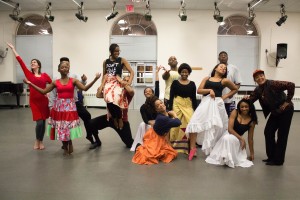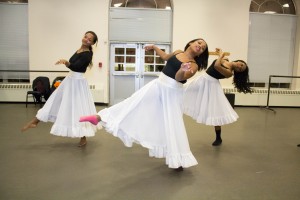By: Brianna Holcomb
Arts & Entertainment Editor
Students, family, alumni and children all gathered in Adams Playhouse on Feb. 8 to watch the Black History Month dance concert, African Diaspora: Music and Dance in the Old and New Worlds.
This show took the audience on a musical journey, featuring West African drumming and dancing; South African choral music; concert music by African, Latin American and African-American composers; and Cubop (Cuban bebop) and Calypso dances for Big Band.
The acts consisted of the Imani Winds, the Hofstra Chamber Choir, Uniondale Rhythm of Knight Show Choir, Hofstra Jazz Ensemble and others.The show depicted how music and dance spread from Africa to various parts of the world. As an audience member, it was easy to see the connection and common threads woven together that made up each musical performance.
The show was hosted by Maya Carter, a junior pursuing a BFA in theater arts with a concentration in performance. Carter has worked on the Black History Month Concerts since she was a freshman at Hofstra. As the host this year she says, “Working on these concerts is a welcome opportunity to celebrate my history as an African American woman, and shed light on the integral position that the arts hold in the black community.”
Carter was able to weave together each act using narrative and poetic passages to show the story and travel of African music as well as culture throughout the different performances.
The show started off with the drumming traditions of South and West Africa, and African classical songs performed by Liberian-American soprano, Dawn Padmore.
Dawn Padmore is a Liberian-born singer who has been referred to as “a resonating soprano” by The New York Times music critic Bernard Holland.
Among the acts of the first half of the show were the Imani Winds. Imani WInds is a Grammy-nominated quintet wind group known as one of the most successful chamber music ensembles in the United States.
The focus of the second half of the show was geared towards Latin America and featured a variety of ensembles. These groups included William Grant Still’s “Danzas de Panama” for orchestra segues, andwork based on a traditional Afro-Colombian folk dance by Hofstra student composer Andres Maldonado.
Recent alum Maldonado, ‘14, has composed work based on a traditional Afro-Colombian folk dance. His composition was written as a senior recital piece dedicated to his mother.
Maldonado explains that Afro-Colombian music “[Is] a genre of music called a Cumbia which is heavily rooted in Colombia’s Afro-Colombian community. It was a dance of courtship by African slaves in 17th century Colombia, as well as a dance of freedom and liberty. The percussion instruments are of African origin. The text of the music is taken from the love sonnet, ‘Midday XXXIV,’ by the Latin American poet, Pablo Neruda,” said Maldonado. “I’m Colombian on my mother’s side, so I wanted to create a piece that combined the beautiful lyricism of Neruda and the highly rhythmic energy of a Cumbia to capture her joy, exuberance and ever-present beauty that my family and those close to her knew and loved.”
This show was able to capture Maldonado’s love for his mother and the various musical influences the African culture was able to spread.


